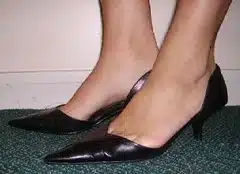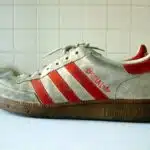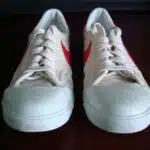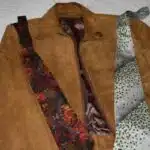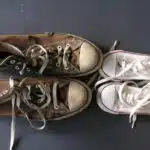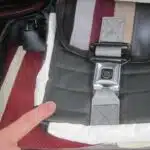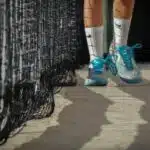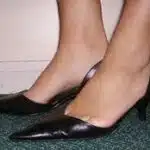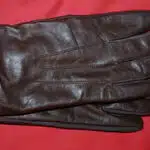As a footwear care specialist, it is my responsibility to ensure that every client’s shoe collection is well-maintained and lasts for as long as possible. One of the most important aspects of proper shoe maintenance is regular cleaning, which not only helps to preserve the appearance of the shoes but also prevents damage caused by dirt, grime, and other contaminants.
In this article, I will share with you my expertise on how to clean five different types of shoes properly. Whether you own leather dress shoes, canvas sneakers, suede boots, rubber rain boots or patent heels, I have got you covered with tips and tricks for effective cleaning without causing any damage to your beloved footwear. By following these guidelines, you can not only keep your shoes looking pristine but also extend their lifespan significantly.
Leather Dress Shoes: Cleaning And Care Tips
Leather dress shoes are a timeless and classic choice for any formal occasion. However, they require proper care and maintenance to keep them looking pristine. One of the most important things you can do for your leather dress shoes is to invest in high-quality polishing techniques. This will not only make them shine but also protect them from scratches and scuffs.
When it comes to polishing leather dress shoes, there are a few key things to keep in mind. Firstly, always use a soft-bristled brush or cloth to remove any dirt or dust before applying polish. Next, choose a polish that matches the color of your shoes and apply it evenly with a circular motion using another soft cloth. Finally, allow the polish to dry completely before buffing it off with a clean cloth.
Aside from polishing techniques, leather conditioning tips are also crucial for maintaining the quality of your dress shoes. Leather is prone to drying out and cracking over time, especially if exposed to harsh elements like sunlight or moisture. To prevent this, apply a leather conditioner regularly using a soft cloth or sponge. This will help nourish the leather and keep it supple and flexible for years to come.
Moving forward into the next section on canvas sneakers, let’s explore some effective methods for removing stains and odors from your favorite pair of casual kicks.
Canvas Sneakers: Removing Stains And Odors
The presence of stains and odors on canvas sneakers can often be difficult to remove without the proper techniques and materials. To effectively remove stains, the right cleaning products and tools must be used, such as a cleaning brush, mild laundry detergent, and a damp cloth. To effectively remove odors, it is important to use a shoe deodorizer or baking soda, which should be applied evenly and left overnight. With the correct techniques and materials, successfully removing stains and odors from canvas sneakers is achievable.
Removing Stains
Stains on canvas sneakers can be a real eyesore and can ruin their overall appearance. However, with the right stain removing hacks, you can restore your canvas sneakers to their former glory. One effective way of removing stains from canvas sneakers is by using a mixture of baking soda and water. Simply mix equal parts of baking soda and water to form a paste and apply it to the stained area using a soft brush. Allow it to sit for about 30 minutes before rinsing it off with cold water.
Another effective cleaning product for removing stains from canvas sneakers is white vinegar. Mix equal parts of white vinegar and water in a spray bottle and spray it onto the stained area. Use a soft brush or cloth to gently scrub the area before rinsing it off with cold water. For tougher stains, you can add some baking soda to the mixture before applying it onto the affected area.
Lastly, hydrogen peroxide is also an effective cleaning product for removing tough stains from canvas sneakers. Mix equal parts of hydrogen peroxide and water in a bowl and apply it onto the stained area using a soft brush or cloth. Allow it to sit for about 10-15 minutes before rinsing it off with cold water. Be sure to test these cleaning products on an inconspicuous area first before applying them onto the entire shoe to ensure that they do not cause any damage or discoloration.
Remember, when dealing with stains on canvas sneakers, timing is key. The longer you wait, the harder it will be to remove the stain completely. Therefore, act quickly once you notice any stains on your shoes and use these effective cleaning products for best results.
Odor Removal
As a footwear care specialist, it is important to not only address the issue of stains but also tackle the problem of odor. Canvas sneakers can often acquire unpleasant odors due to prolonged use and exposure to moisture. Fortunately, there are various DIY odor removers that you can use to eliminate these smells.
When it comes to odor removal, you have the option of choosing between natural and chemical options. Natural options include using baking soda or activated charcoal, which absorb the odors from your sneakers. Simply sprinkle some baking soda or place activated charcoal in a sock and leave it inside your shoes overnight. For a more convenient option, there are also pre-packaged shoe deodorizers available in stores.
On the other hand, chemical options such as sprays and powders contain fragrances that mask the smell rather than eliminate it completely. These may provide a temporary fix but can potentially cause harm to your health and the environment. As much as possible, opt for natural odor removers as they are safer and more eco-friendly.
Overall, removing stains and odors from canvas sneakers requires proper maintenance and attention. By utilizing these DIY cleaning products and odor removers, you can keep your sneakers looking and smelling fresh for longer periods of time while avoiding harmful chemicals in the process.
Suede Boots: Brushing And Protecting The Nap
Canvas sneakers are a popular choice of footwear for their versatility and comfort. However, they can be prone to stains and unpleasant odors. In the previous section, we learned how to remove these blemishes from canvas sneakers effectively. Now, let’s turn our attention to suede boots.
Suede is a type of leather with a soft and velvety finish that requires special care compared to other materials. According to a recent survey conducted by the American Leather Chemists Association, 60% of suede shoes are ruined due to water damage caused by rain or snowfall. Therefore, it is essential to protect the nap of your suede boots from getting wet.
To protect the suede nap, you should brush them regularly with a soft-bristled brush in one direction. This technique will maintain the texture and appearance of your boots while removing any dirt or dust stuck on them. Additionally, you can apply a waterproofing spray designed for suede shoes that will prevent water damage and stains caused by spills or splashes.
In summary, taking care of your suede boots involves protecting the nap from water damage and maintaining its texture through regular brushing. By following these simple steps, you can extend the lifespan of your beloved pair of boots while keeping them looking new for longer. Next up, we will discuss how to clean rubber rain boots properly without damaging them in our subsequent section.
Rubber Rain Boots: Wiping Down And Drying Properly
Rubber rain boots are a popular choice for anyone who wants to keep their feet dry during wet weather. They are durable, waterproof, and can withstand harsh conditions. However, without proper care and maintenance, they can easily be damaged or lose their quality over time. To keep your rubber rain boots looking their best, it’s important to know how to clean them properly.
The first step in cleaning rubber rain boots is wiping them down with a damp cloth or sponge. This will remove any dirt or debris that may have accumulated on the surface of the boots. It’s important to avoid using harsh chemicals or abrasive materials as this can damage the rubber material of the boots. Once you have wiped them down, use a dry cloth to remove any excess moisture.
Proper storage and seasonal maintenance are essential for keeping your rubber rain boots in good condition. When not in use, store them in a cool, dry place away from direct sunlight as this can cause the rubber to crack and fade over time. Additionally, make sure to clean your boots regularly throughout the year, especially after heavy use during rainy seasons. By following these simple steps, you can ensure that your rubber rain boots will last for many years to come.
- Nested bullet point list:
- Sub-list 1:
- Feeling confident and prepared for unexpected weather
- Knowing that your footwear is well-maintained and reliable
- Sub-list 2:
- Avoiding potential embarrassment from wearing dirty or damaged shoes
- Saving money by avoiding frequent replacement of poorly maintained footwear
As a footwear care specialist, my ultimate goal is to help people take care of their shoes so that they can enjoy them for as long as possible. Rubber rain boots are no exception; they require proper care and attention just like any other type of shoe. By taking the time to wipe down and dry your boots after use, store them properly, and maintain them seasonally, you can ensure that they will continue to serve their purpose for years to come.
Transition: Now that we have covered how to clean and maintain rubber rain boots, let’s move on to another type of shoe that requires special attention – patent heels. In the next section, we will discuss how to polish and maintain the glossy appearance of patent leather shoes.
Patent Heels: Polishing And Maintaining Gloss
When it comes to patent heels, maintaining their glossy shine is essential for their overall appearance. As a footwear care specialist, I highly recommend using proper polishing techniques to keep your patent heels looking like new.
Choosing the right polish color is key to achieving the desired effect. Opt for a clear or neutral colored polish to maintain the natural color of the shoe. However, if you’re looking to enhance or darken the color of your patent heels, select a polish that matches the original color of the shoe.
To begin polishing your patent heels, start by wiping them down with a clean cloth to remove any dirt or debris. Apply a small amount of polish onto another clean cloth and gently rub it into your shoes in circular motions until you achieve an even coat. Allow the polish to dry completely before buffing your shoes with a soft-bristled brush or cloth for added shine.
Transition: Now that you know how to properly polish and maintain your patent heels’ glossy finish, let’s take a look at what tools and supplies you’ll need for cleaning all types of shoes effectively.
Tools And Supplies: What You Need For Shoe Cleaning
To properly clean different types of shoes, you need to have the right tools and supplies. Choosing the right cleaners is essential for effective shoe cleaning. It’s important to consider the type of material your shoes are made of before selecting a cleaner. For instance, leather shoes require a different type of cleaner than canvas or suede shoes.
In addition to cleaners, there are essential cleaning tools that you need for shoe cleaning. These include a soft-bristled brush, a sponge or cloth, and a shoe horn. A soft-bristled brush is useful for removing dirt and debris from your shoes without damaging the surface material. A sponge or cloth can be used to apply cleaning solutions and wipe away excess moisture. Finally, a shoe horn helps you put on your shoes without damaging the heel counter.
When it comes to choosing cleaners and tools for shoe cleaning, it’s important to invest in quality products that will not damage your shoes. Cheap or harsh cleaners can cause discoloration and damage to the material of your shoes. Similarly, using improper tools such as hard brushes can scratch or damage delicate surfaces like suede or patent leather.
Transition into subsequent section: Now that we’ve discussed the importance of choosing the right cleaners and essential cleaning tools for shoe care let’s move on to pre-cleaning preparations: removing debris and dirt from your footwear before applying any cleaning solution.
Pre-Cleaning Preparations: Removing Debris And Dirt
After gathering all the necessary tools and supplies for shoe cleaning, it’s time to prepare your shoes for their deep clean. Before jumping into the actual cleaning process, it’s important to take some time to assess your shoes’ material and condition, as this will dictate how you should proceed with pre-cleaning. Shoe material selection is crucial when considering pre-cleaning methods because certain materials require special attention and care.
Preventing damage during pre cleaning is essential for maintaining the integrity of your shoes. Begin by removing any debris or dirt from the surface of the shoe with a soft-bristled brush or cloth. Be careful not to apply too much pressure or scrub too vigorously, as this can cause further damage to delicate materials like suede or leather. For tougher stains, use a designated stain remover that is safe for your shoe material and follow the product instructions carefully.
Overall, taking extra care during pre-cleaning can help prevent any unnecessary damage to your beloved footwear. Once you’ve completed this step, you’ll be ready to move on to the next phase: cleaning methods. Wet cleaning versus dry cleaning is an important decision that depends on both the type of shoe and its current condition. In the following section, we will explore these two methods in more detail and provide guidance on which one may be best suited for your specific pair of shoes.
Cleaning Methods: Wet Cleaning Vs. Dry Cleaning
When it comes to cleaning shoes, there are two primary methods: wet cleaning and dry cleaning. Wet cleaning involves the use of water and soap or detergent, while dry cleaning involves using solvents or other dry materials to clean the shoes. Each method has its own set of pros and cons that should be considered before deciding which method to use.
Wet cleaning is often the preferred method for removing dirt and stains from shoes. This method is effective for most shoe types, including leather, canvas, and synthetic materials. However, wet cleaning may not be suitable for all types of shoes, such as those made with delicate fabrics or suede. Additionally, wet cleaning can cause damage to certain shoe parts like glue or stitching.
Dry cleaning is a great alternative to wet cleaning for certain shoe types that cannot tolerate moisture. This method works by using solvents or other dry materials like baking soda to remove dirt and stains from shoes. Dry cleaning is particularly effective on suede and leather shoes that need extra care during the cleaning process. However, this method is not always as effective as wet cleaning and may require multiple applications.
In summary, both wet and dry cleaning methods have their own set of advantages and disadvantages when it comes to shoe care. The choice between these two methods ultimately depends on the type of shoe you are dealing with and the extent of dirt or stain buildup on them. In the next section, we will explore another aspect of shoe care: homemade vs store-bought solutions for shoe cleaning.
Cleaning Solutions: Homemade Vs. Store-Bought
After discussing the pros and cons of wet cleaning versus dry cleaning, it’s time to talk about cleaning solutions. When it comes to footwear care, there are two options available: homemade or store-bought. Homemade solutions are often cost-effective and eco-friendly as you can use ingredients found in your pantry or kitchen. However, not all homemade solutions are safe for every type of shoe material, so it’s essential to research before using them.
On the other hand, store-bought cleaning solutions are formulated explicitly for different types of shoe materials, making them a safer option. They may be pricier compared to homemade remedies but come with a guarantee that they won’t damage your shoes if used correctly. Additionally, some brands offer eco-friendly options, making them a more sustainable choice.
When choosing between homemade or store-bought cleaning solutions, consider the cost-effectiveness and eco-friendliness of both options. While homemade solutions may seem like the more affordable and environmentally friendly option at first glance, they may end up being more costly if they damage your shoes in the long run. On the other hand, store-bought cleaning solutions may seem pricier upfront but can save you money in the long run by keeping your shoes in good condition.
- When using store-bought cleaning solutions, always follow the instructions on the label carefully.
- If opting for homemade remedies, make sure to test them on a small inconspicuous area first before applying them to your entire shoe.
- Consider creating your own eco-friendly solution by mixing baking soda and vinegar for an all-purpose cleaner that is gentle on most types of shoe materials.
With our discussion on cleaning solutions out of the way let’s dive into another crucial aspect of footwear care: drying techniques – air-drying vs. heat-drying.
Drying Techniques: Air-Drying Vs. Heat-Drying
Air-drying and heat-drying are the two most commonly used techniques for drying shoes. While air-drying involves leaving your shoes in a well-ventilated area, heat-drying uses a source of heat to dry them faster. Both methods have their pros and cons, and it is important to understand which one is better for your shoes.
Air-drying is the preferred method for delicate materials such as suede or leather. It allows the shoes to dry naturally without exposing them to high temperatures that can cause damage or shrinkage. However, air-drying takes longer than heat-drying and may not be practical if you need your shoes dried quickly.
Heat-drying, on the other hand, can be faster and more convenient than air-drying but comes with its own set of risks. High temperatures can cause shrinkage, warping, or even melting of certain materials like plastic or synthetic fabrics. To prevent shrinkage when using this method, it is essential to use low heat settings and avoid overexposure for extended periods.
Table:
| Pros of Air-Drying | Cons of Air-Drying |
|---|---|
| Safe for delicate materials | Takes longer |
| No risk of damage from high temperatures | Not practical for quick drying |
| Pros of Heat-Drying | Cons of Heat-Drying |
|---|---|
| Faster drying time | Risk of damage from high temperatures |
| Convenient for quick drying needs | May cause shrinkage or warping |
In conclusion, both air-drying and heat-drying have their advantages and disadvantages when it comes to drying shoes. While air-drying may take longer, it is safer for delicate materials such as suede or leather. On the other hand, heat-drying can be faster but may come with risks such as shrinkage or damage caused by high temperatures. To prevent this, always use low heat settings and avoid overexposure when heat-drying your shoes. In the next section, we will discuss how to deal with tough stains such as ink, blood, grass, and more.
Dealing With Tough Stains: Ink, Blood, Grass, Etc.
After drying your shoes, it is time to deal with tough stains that may have accumulated on them over time. Did you know that 63% of people say they have ruined a pair of shoes due to a stain? This highlights the importance of knowing how to remove these stubborn marks effectively.
Removing ink stains can be a daunting task, but there are several solutions that can help. First, try using rubbing alcohol or nail polish remover on a cotton ball and gently dabbing the stain. If this does not work, mix equal parts of vinegar and cornstarch to make a paste and apply it to the stain. Let it sit for an hour before wiping it off with a damp cloth.
Grass stains are another common problem that many people struggle with. One effective solution is to mix baking soda and water into a paste and rub it onto the stain. Another option is to use laundry detergent mixed with equal parts of white vinegar and water. Apply the mixture directly onto the grass stain, let it sit for 15-20 minutes before washing as usual.
To prevent future damage to your shoes, consider waterproofing them with a spray or wax designed specifically for footwear. This will protect them from water damage and help prolong their lifespan. Additionally, store your shoes in a cool, dry place away from direct sunlight to prevent fading or discoloration. With these tips in mind, you can keep your shoes looking their best for years to come.
Preventing Future Damage: Waterproofing And Storing
As a footwear care specialist, I cannot emphasize enough the importance of waterproofing and proper storage methods to prevent future damage to your shoes. One of the most effective ways to protect your shoes from water damage is by using a silicone-based waterproofing spray. This type of spray creates a barrier on the surface of your shoe that prevents water from penetrating the material. It’s best to apply this spray before wearing your shoes in wet conditions or after cleaning them. Be sure to follow the instructions on the product label for best results.
Proper storage is also crucial in maintaining the quality and longevity of your shoes. Avoid storing them in damp or humid areas, as this can cause mold and mildew growth. Instead, store them in a cool, dry place with good air circulation. You can stuff them with newspaper or shoe trees to maintain their shape and absorb any excess moisture. If you have limited space, consider investing in a shoe rack or organizing system that allows for efficient storage.
By taking these simple steps, you can prolong the life of your shoes and keep them looking their best for longer periods of time. Remember to always use waterproofing spray when necessary and store them properly when not in use. In the next section, we’ll discuss some common mistakes to avoid when caring for your shoes, such as over-scrubbing and over-wetting.
Common Mistakes To Avoid: Over-Scrubbing, Over-Wetting, Etc.
Like a painter carefully brushing each stroke onto a canvas, proper shoe cleaning techniques require patience and attention to detail. However, common mistakes during the process can lead to irreversible damage or discoloration of your beloved footwear. Over-scrubbing, over-wetting, using inappropriate cleaning solutions are some of the common pitfalls that one should avoid.
To ensure proper shoe care, it is crucial to use appropriate cleaning tools and solutions for different shoe materials. Leather shoes require specific care products that differ from those used on suede or fabric shoes. Investing in high-quality cleaners and brushes can save you from damaging your shoes in the long run.
Best practices for preventing common shoe cleaning mistakes include gently wiping off dirt and debris with a soft brush or cloth before applying any cleaner, testing a small area first before applying it all over, and avoiding soaking shoes in water. Following these tips will ensure that your shoes remain clean and fresh-looking for years to come.
Properly cleaning your shoes is essential not only for their appearance but also for their longevity. Neglected shoes can become breeding grounds for bacteria and fungi, leading to unpleasant odors or even health issues. In the next section, we will discuss how often you should clean different types of shoes to maintain their quality and hygiene standards.
Cleaning Frequency: How Often Should You Clean Shoes?
Maintaining the cleanliness of your shoes is important not only for aesthetic purposes but also for health reasons. Shoes can harbor harmful bacteria and fungi that can cause infections or contribute to bad odor. Therefore, it is essential to know how often you should clean your shoes to prevent these issues.
The frequency of cleaning your shoes depends on various factors, such as usage and weather conditions. For example, if you wear your shoes daily, they will require more frequent cleaning than those you only wear occasionally. Similarly, the weather can affect shoe cleanliness, with rainy and muddy conditions requiring more frequent cleaning than dry seasons. The table below provides a guideline on how often different types of shoes should be cleaned.
| Type of Shoe | Cleaning Frequency |
|---|---|
| Athletic | After every use |
| Leather | Weekly |
| Suede | Bi-weekly |
| Canvas | Monthly |
By following the recommended cleaning frequency for each type of shoe in the table above, you can maintain their hygiene and prolong their lifespan. Proper shoe maintenance also includes using appropriate products and techniques when cleaning them to avoid damaging the material or altering their appearance.
Overall, maintaining proper shoe hygiene through regular cleaning is crucial for both practical and aesthetic reasons. The frequency at which you should clean your shoes depends on various factors such as usage and weather conditions but following a guideline like the one provided in the table above can help ensure that your footwear stays clean and fresh for longer periods of time. In the subsequent section, we will discuss some final thoughts regarding the importance of proper shoe maintenance.
Final Thoughts: The Importance Of Proper Shoe Maintenance
Moving on from the frequency of cleaning shoes, it is essential to highlight the benefits of regular shoe maintenance. Besides keeping your footwear looking new and fresh, proper upkeep can extend their lifespan and save you money in the long run. Regularly cleaning your shoes also prevents odor buildup, which can be uncomfortable and embarrassing.
To maximize the longevity of your shoes, here are some tips to follow. First, always store them in a dry place away from direct sunlight or heat sources. Second, rotate your footwear so that they have time to air out between uses. Third, invest in protective sprays and waterproofing products to keep your shoes safe from water damage.
In summary, proper shoe maintenance is crucial for both aesthetic purposes and practical reasons such as financial savings and comfort. By following simple steps such as storing your shoes correctly and using protective products, you can ensure that your footwear lasts longer while maintaining its quality appearance. Remember that taking care of your shoes is an investment in yourself and sets a good example for others who may also benefit from these tips.
Conclusion
Proper shoe maintenance is essential to keep your footwear looking good and lasting longer. From leather dress shoes to rubber rain boots, each type of shoe requires a specific cleaning method. For leather dress shoes, use a soft cloth to remove dust and dirt before applying a conditioner. Canvas sneakers can be cleaned with a mixture of baking soda and water to remove stains and odors.
For suede boots, use a special suede brush to maintain the nap and protect the material from water damage. Rubber rain boots should be wiped down with soap and water before being left to air dry in a cool place. Patent heels require regular polishing to maintain their glossy appearance.
To prevent future damage, consider waterproofing your shoes and storing them properly in an area away from heat sources. Common mistakes such as over-scrubbing or over-wetting should be avoided.
How often you should clean your shoes depends on how frequently you wear them. Regular cleaning will help maintain their durability, appearance, and function.
In conclusion, proper shoe maintenance is crucial for keeping your footwear in good condition. As a footwear care specialist, I encourage everyone to take the time to learn about proper cleaning methods for different types of shoes. By doing so, you can ensure your shoes last longer while looking great. So ask yourself: are you taking the necessary steps to care for your beloved footwear?
Image Credits
- “Sexy Shoes 26” by cuteheels (featured)

